By: Daure David
Fresh developments in Taraba’s political landscape suggest that Governor Agbu Kefas’ rumored defection from the Peoples Democratic Party (PDP) to the All Progressives Congress (APC) is far more than a spontaneous decision it is part of a well-crafted political strategy backed by powerful interests seeking to consolidate control ahead of the 2027 general elections.
While official confirmation remains pending, multiple sources within both the PDP and APC circles confirm that talks are ongoing, with Kefas at the center of what is being described as a high-level “strategic repositioning.” Insiders argue that the move is aimed not at abandoning the PDP but at building a dual political structure that would guarantee Southern Taraba’s continued hold on power regardless of which party emerges victorious in the next election cycle.
A Bridge Between Two Camps
Observers familiar with the strategy compare it to the 2023 political maneuvering that saw Senator Emmanuel Bwacha contest under the APC while retaining significant influence among PDP loyalists. This time, however, the approach appears more calculated. Governor Kefas is being positioned to function as the PDP bloc within the APC a bridge figure meant to straddle both sides of the aisle.
“The idea is simple: secure power through multiple fronts,” a senior political aide who asked not to be named told The Taraba Times. “By positioning Governor Kefas in the APC and another loyalist in the PDP, the Southern zone guarantees political continuity and influence no matter the outcome of 2027.”
The “Oga’s Boy” Factor
At the heart of the strategy lies what insiders describe as the emergence of the “Oga’s Boy” a candidate expected to carry the PDP flag in 2027 with the backing of influential political stakeholders from within and outside the state. This carefully selected candidate would be a close ally of both the governor and the key power brokers behind the scenes.
With Governor Kefas potentially anchoring the APC front and the “Oga’s Boy” leading the PDP charge, the region creates a win-win scenario. Regardless of the outcome, Southern Taraba which has already held the governorship for nearly 12 years under Governors Darius Ishaku and Kefas — is poised to extend its dominance well into the next decade.
Strategic Positioning, Not Defection
Political analysts describe the move as “strategic positioning,” not a traditional defection. Rather than severing ties with the PDP, Kefas is believed to be acting as a tactical operator aligning with national APC forces while maintaining local PDP structures.
“To the untrained eye, this looks like betrayal or political confusion,” said Dr. Hassan Maikudi, a political scientist at Taraba State University. “But this is classic realpolitik a consolidation of regional power using cross-party platforms. It’s an insurance policy against political loss.”
Risks and Rewards
While the strategy appears airtight on paper, it is not without risks. Kefas’ defection could alienate a portion of his PDP base, ignite factional crises, or backfire if either party rejects the dual-allegiance approach. However, if successfully executed, it could reshape Taraba’s political map and serve as a model for power retention in other states.
The Bigger Picture
As the 2027 elections draw closer, the political chessboard in Taraba is beginning to take shape. What may look like a crack in party loyalty could, in fact, be the opening move in a broader strategy of dominance — one that ensures that Southern Taraba remains firmly in control, no matter which party wins the day.
For now, Governor Kefas has made no official statement regarding the defection rumors. But if the whispers in political corridors are true, Taraba may be witnessing one of the most sophisticated political realignments in its recent history.







